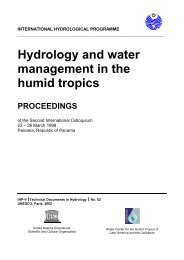FR AB - Science Reference
FR AB - Science Reference
FR AB - Science Reference
You also want an ePaper? Increase the reach of your titles
YUMPU automatically turns print PDFs into web optimized ePapers that Google loves.
<strong>AB</strong>RF 2001 <strong>AB</strong>STRACTS<br />
P57-T<br />
Optimization of a procedure for labeling proteins with isotopecoded<br />
affinity tags.<br />
K. Parker, S. Pillai, S. Daniels, W. Stanick, R. Lotti, B. Purkayastha,<br />
T. Nadler; Applied Biosystems, 500 Old Connecticut Path, Framingham,<br />
MA 01701<br />
The use of the isotope coded affinity tag (ICAT), developed by the laboratory<br />
of R. Aebersold (Nat. Biotechnol. 1999 Oct 17(10):994–9), allows one<br />
to compare the relative protein abundance between two samples by mass<br />
spectrometry. The reagent used is essentially cysteine reactive biotinylation<br />
reagent into which stable isotopes have been incorporated. One of the two<br />
samples is treated with the light reagent while the other sample is treated<br />
with the same reagent containing 8 deuterium atoms such that the samples<br />
are chemically equivalent but differ only in mass. In this way two peptides<br />
may be monitored in the mass spectrometer and quantified relative to one<br />
another by peak intensity.<br />
A number of imporant questions concerning the use of this technique are<br />
addressed in this presentation. The reagent has been extensively characterized<br />
and the recommended protocol for its use has been optimized for ease<br />
of use and robustness. Experiments were carried out to determine the purity,<br />
stability, and reaction kinetics of the reagent. Additional experiments were<br />
performed to optimize the derivatization protocol, including measurements<br />
of the degree of alkylation obtained, determining the optimal reduction<br />
reagent, how to remove excess reagent, and measurements of stability,<br />
capacity, carryover, and recovery of biotinylated peptides from monomeric<br />
avidin columns, Finally, the reproducibility of quantitative measurements in<br />
the mass spectrometer was addressed and will be presented.<br />
P59-M<br />
Quantitative proteomic and mRNA expression analysis of<br />
S. cerevisiae via metabolic labeling and multidimensional<br />
protein identification technology.<br />
M.P. Washburn1, G. Oshiro2, D. Wolters1, D. Schieltz1, C. Deciu1, E. Winzeler2, J.R. Yates, III1; 1Novartis Agr. Discovery Inst., 3115 Merryfield<br />
Row Suite 100, San Diego, CA 92121, 2Genomics Inst. of Novartis Fndn.,<br />
San Diego<br />
Proteomic technologies are being developed to determine large-scale<br />
changes in protein expression levels. Several quantitative proteomic methods<br />
have recently been published where the protein expression levels are compared<br />
between two different growth conditions by metabolic isotopic labeling<br />
of proteins or post-growth isotopic labeling of proteins in a sample. To<br />
fully understand how growth conditions effect biological systems, both protein<br />
and mRNA expression levels must be analyzed. We have applied metabolic<br />
labeling strategies to S. cerevisiae in order to determine the changes in<br />
protein and mRNA expression levels. S. cerevisiae was grown in 15N enriched<br />
minimal media and compared to S. cerevisiae grown in rich media. Each sample<br />
was analyzed via mRNA expression array and multidimensional protein<br />
identification technology. By combining these methods we were able to correlate<br />
the changes in protein and mRNA expression levels of several hundred<br />
gene products.<br />
POSTER <strong>AB</strong>STRACTS<br />
202 JOURNAL OF BIOMOLECULAR TECHNIQUES, VOLUME 11, ISSUE 4, DECEMBER 2000<br />
P58-S<br />
Rapid genotyping using spectrometrically monitored selections.<br />
J. Stoerker1, J.D. Mayo2, C.N. Tetzlaff3, D.A. Sarracino4, C. Richert3; 1Bruker Daltonics, 15 Fortune Drive, Billerica, MA 01821, 2Tufts Univ.,<br />
3Univ. of Konstanz, 4Variagenics, Inc.<br />
Presented here is an inexpensive and rapid method for genotyping single<br />
nucleotide polymorphisms (SNPs) on PCR products using spectrometrically<br />
monitored selection from probe libraries. We have previously reported nuclease<br />
selections of modified oligonucleotides with increased RNA or DNA targets.<br />
This methodology relies on the selection of short hybridization probes<br />
complementary to the target sequence with a single-strand specific nuclease<br />
that does not attack duplexes. Conditions are described where the matched<br />
duplex is profoundly better protected from enzymatic digestion than single<br />
base mismatches. Semi-quantitative MALDI-TOF MS is used to identify the<br />
selected probes after a 10-minute digestion reaction with snake venom phosphodiesterase.<br />
We have examined sequences from exon 10 of the cystic<br />
fibrosis transmembrane regulatory (CFTR) gene, using a probe library representing<br />
a number of alleles, including: native, I506S, 1651 benign polymorphism,<br />
I506S/1651 dual polymorphism, and dF508, and dI507. Probe<br />
libraries composed of 8-mers and 9-mers annealing to PCR products have<br />
been used in our experiments. DNA from blood or cheekbrush samples was<br />
used from 10 genomic sources. The method discriminates both alleles of a<br />
heterozygote pair in a single experiment, and can discriminate alleles from<br />
multiple loci in the same sample.<br />
P60-T<br />
A software algorithm for automated quantitation of ICAT labeled<br />
peptides analyzed by mass spectrometry is described.<br />
J. Eng, J. Ranish, R. Aebersold; Inst. for Systems Biol., 4225 Roosevelt<br />
Way NE, #200, Seattle, WA 98105<br />
We describe a software program which automatically generates quantitation<br />
ratios of Isotope Coded Affinity Tag (ICAT) labeled peptides analyzed in an<br />
LC-MS/MS experiment performed on an LCQ ion trap mass spectrometer. The<br />
peptides are initially identified via a sequence database search. Quantitation<br />
of each ICAT-labeled peptide pair is then performed by integrating over the<br />
peptide’s light and heavy elution profiles. An interactive, graphical program<br />
displays the light and heavy elution traces and allows the researcher to<br />
adjust the area of integration as needed. This program should enable and<br />
facilitate large scale, quantitative proteomics studies.















